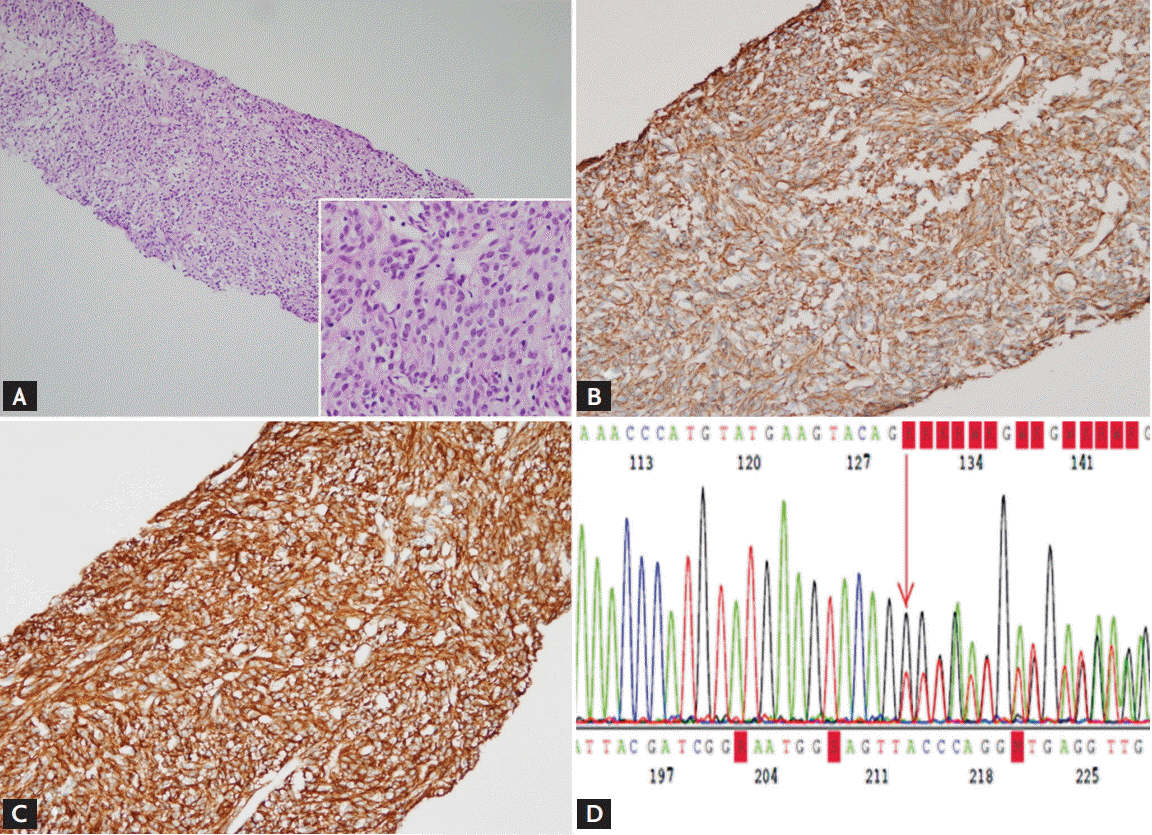 |
 |
| Korean J Intern Med > Volume 32(2); 2017 > Article |
|
A 45-year-old woman was referred with a huge mass of the liver. She complained of a vague abdominal discomfort that had persisted for 1 month. She had no history of liver disease, and physical examination revealed mild abdominal distension. Pertinent laboratory test results were unremarkable. She had a history of small intestinal resection for a gastrointestinal stromal tumor (GIST) 11 years prior (Fig. 1A). Computed tomography (CT) showed a heterogeneous hypervascular tumor with central necrosis, occupying left hemiliver and right paramedian sector of the liver, measuring 20 ├Ś 13 cm (Fig. 1B). Positron emission tomography-CT using 18F-fluorodeoxyglucose showed intense hypermetabolic activity (maximum standardized uptake value 8.2) along the peripheral solid portion of the tumor with central photon defect area representing necrosis (Fig. 1C). A tumor biopsy revealed small round/spindle-shaped cells surrounded by fibrous tissue. Immunohistochemical stainings revealed vimentin reactivity, as well as CD117 reactivity. On c-kit sequencing, a deletion in exon 11 was identified. Based on the patientŌĆÖs history, positive staining for CD117, and c-kit mutation results, the neoplasm was diagnosed as a metastatic GIST in the liver (Fig. 2). The pros and cons of using imatinib were discussed, and the patient was started at a dose of 400 mg/day and the dose had been tapered to 200 mg/day. One year follow-up CT showed the hepatic tumor slightly diminished in size, but stabilized at a size of 18 ├Ś 13 cm (Fig. 1D).
GISTs in the small bowel tend to be more aggressive than those in the stomach. The liver is most common metastatic site. Although hepatic metastasis of a GIST is not uncommon, delayed metastasis over 5 years later is extremely rare. A few cases of inoperable liver metastatic GISTs have been reported, most were treated by a multidisciplinary approach including imatinib administration and subsequent portal vein embolization leading to tumor shrinkage which enables curative resection.
Acknowledgments
We grate Dr. Dae Jung Kim, Department of Radiology, CHA Bundang Medical Center, CHA University for providing a valuable CT picture of the patient (Fig. 1A).
Figure┬Ā1.
(A) Eleven years ago, a small intestinal gastrointestinal stromal tumor, 11 ├Ś 6 cm size, of the patient was resected (arrowheads). (B) Abdominal computed tomography (CT) showing a heterogeneous hepatic tumor with central necrosis, measuring 20 ├Ś 13 cm. Note peripheral rim of the tumor displaying heterogeneous enhancement, indicating viable tumor portion (arrows). (C) Positron emission tomography-CT showing two contrasting 18F-fluorodeoxyglucose (FDG) uptake patterns of the tumor: the peripheral solid portion showing high metabolic rate (arrow, maximum standardized uptake value 8.2) and most of the inner portion showing FDG-void pattern, representing necrosis. (D) After 1 year of imatinib treatment, the tumor size reduced slightly to a size of 18 ├Ś 13 cm. Note the loss of peripheral enhancement of solid portion (arrows).





 PDF Links
PDF Links PubReader
PubReader ePub Link
ePub Link Full text via DOI
Full text via DOI Download Citation
Download Citation Print
Print



